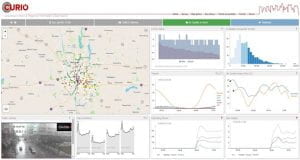The 21st century witnessed an epochal event in human civilization: in 2008, the world became majority urban for the first time in history. Urbanization is accelerating: two-thirds of the global population will live in cities by 2030. Some scholars are projecting an essentially urban planet by the end of the century, with 90% of the world population crowded into urban areas. A world of 10 billion people living predominantly in cities— of which 60% globally have yet to be built —underscores the critical need and immense opportunity for new scientific and policy approaches that can achieve sustainable urban systems.

Figure 1: Locations reachable at 6pm on a typical weekday from the Linden neighborhood of Columbus by public transit and walking after new CMax bus rapid transit service. Graphic courtesy of Harvey Miller
Mobility is central to urbanity: transportation is how we organize our cities. While the personal automobile has generated stunning levels of travel and activity over the past century, it has also led to urban transportation systems being inefficient, costly, inequitable, unsafe and unhealthy, and damage environments at local to global scales. This is leading to a mobility crisis that will get worse as the world continues to urbanize.
In many cities, we are seeing the deployment of new technology-enabled mobility services such as vehicle sharing, hailing services, and micromobility such as scooters and bikeshare systems. These innovations are disrupting the mobility landscape of cities, with even larger disruptions inevitable with the coming of connected autonomous vehicles. While these hold promise, they also may make an unsustainable situation even worse.
Are New Mobility Technologies Sustainable?
Introducing disruptive mobility technologies to cities is a large-scale, real-world experiment that will impact cities for decades. The outcomes of these mobility disruptions have profound implications for urban air quality, social equity, energy consumption, greenhouse gas emissions, safety and health. So far, the evidence is mixed. For example, some evidence suggest that Lyft and Uber are reducing drunk and impaired driving (although possibly at the expense of heavier drinking). However, these services are also increasing traffic congestion, undermining public transit and leading to higher energy consumption and emissions.

Figure 2: The Columbus Urban and Regional Information Observatory (CURIO) – a geospatial data dashboard for Columbus, Ohio. Graphic courtesy of Harvey Miller
Whether new mobility services will make cities more sustainable is an open question, one that will be difficult to answer using 20th century urban scientific and management approaches. In the past we have relied on simple data and measures that could be easily collected. For example, automobile traffic counts have been easy to collect: consequently our main transportation performance measure is how many vehicles we can shove through a network. Our simple, 20th century models also treat mobility as undifferentiated flow, like water – consequently, we made traffic congestion worse by trying to build bigger “pipes” because of a phenomenon known as induced demand.
In the 21st century, we need transportation measures and analytics that:
- i) focus on people and their activities, not vehicles and their movements;
- ii) recognize the heterogeneity of peoples’ needs and capabilities with respect to mobility and accessibility, and;
- iii) capture the full cost of transportation, especially externalities such as emissions, noise, risk and other social and environmental impacts.
New Geospatial Technologies and Sustainable Mobility Science
New sources of data are emerging that could enable some of this system science. Location-aware technologies such as mobile phones and global position system (GPS) receivers, environmental sensors, social media and smart technologies are generating data at unprecedented volumes and spatio-temporal resolution, facilitating new insights into mobility patterns and urban dynamics. The cost of data storage has plummeted, allowing these data to be saved and archived over time. Advances in machine learning, geospatial data mining, geovisualization and other knowledge discovery techniques are helping specialized and siloed practitioners work together to make sense of this data avalanche. Cloud computing, geospatial data portals, application-programming interfaces and data dashboards allow scientists to share these data and information widely with the public. These new technologies are creating a new kind of data-enabled and computation-rich mobility science that can lead to more nuanced, appropriate and sustainable solutions to our growing urban mobility crisis.
Bob and Mary Reusche Chair in Geographic Information Science
Professor of Geography
Director, Center for Urban and Regional Analysis (CURA)
Some of the geospatial data-enabled sustainable mobility research projects conducted in the OSU Department of Geography and the Center for Urban and Regional Analysis (CURA) include:
- Estimating the energy consumption and CO2 emissions of mobility and accessibility
- Measuring the impacts on accessibility to jobs and healthcare from new public transit services
- Measuring differences in accessibility equity within neighborhoods and communities
- Analyzing how public transit delays propagate over space and time, and the impact of delays on the risk of missing transfers
- Understanding the built environment features that encourage walking
- A urban data dashboard for Columbus that allows residents, community stakeholders and official to understand the spatial and temporal pulse of the city